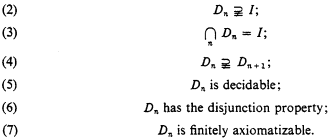Crossref Citations
This article has been cited by the following publications. This list is generated based on data provided by
Crossref.
Gabbay, Dov M.
1975.
Decidability results in non-classical logics.
Annals of Mathematical Logic,
Vol. 8,
Issue. 3,
p.
237.
Kirk, Robert E.
1979.
Some Classes of Kripke Frames Characteristic for the Intuitionistic Logic.
Mathematical Logic Quarterly,
Vol. 25,
Issue. 25-29,
p.
409.
Kirk, Robert E.
1980.
A Characterization of the Classes of Finite Tree Frames Which are Adequate for the Intuitionistic Logic.
Mathematical Logic Quarterly,
Vol. 26,
Issue. 32-33,
p.
497.
Muravitskii, A. Yu.
1984.
A result on the completeness of superintuitionistic logics.
Mathematical Notes of the Academy of Sciences of the USSR,
Vol. 36,
Issue. 5,
p.
883.
Drugush, Ya. M.
1984.
Finite approximability of forest superintuitionistic logics.
Mathematical Notes of the Academy of Sciences of the USSR,
Vol. 36,
Issue. 5,
p.
878.
Van Dalen, Dirk
1986.
Handbook of Philosophical Logic.
p.
225.
Bellissima, Fabio
1989.
Two classes of intermediate propositional logics without disjunction property.
Archive for Mathematical Logic,
Vol. 28,
Issue. 1,
p.
23.
Chagrov, Alexander
and
Zakharyashchev, Michael
1991.
The disjunction property of intermediate propositional logics.
Studia Logica,
Vol. 50,
Issue. 2,
p.
189.
Miglioli, Pierangelo
1992.
An infinite class of maximal intermediate propositional logics with the disjunction property.
Archive for Mathematical Logic,
Vol. 31,
Issue. 6,
p.
415.
Shimura, Tatsuya
1993.
Kripke completeness of some intermediate predicate logics with the axiom of constant domain and a variant of canonical formulas.
Studia Logica,
Vol. 52,
Issue. 1,
p.
23.
Rybakov, Vladimir V.
1994.
Criteria for admissibility of inference rules. Modal and intermediate logics with the branching property.
Studia Logica,
Vol. 53,
Issue. 2,
p.
203.
Skvortsov, D.
1995.
On the predicate logics of finite Kripke frames.
Studia Logica,
Vol. 54,
Issue. 1,
p.
79.
Ferrari, Mauro
and
Miglioli, Pierangelo
1995.
A method to single out maximal propositional logics with the disjunction property II.
Annals of Pure and Applied Logic,
Vol. 76,
Issue. 2,
p.
117.
Ferrari, Mauro
and
Miglioli, Pierangelo
1995.
A method to single out maximal propositional logics with the disjunction property I.
Annals of Pure and Applied Logic,
Vol. 76,
Issue. 1,
p.
1.
Fairtlough, Matt
and
Mendler, Michael
1997.
Propositional Lax Logic.
Information and Computation,
Vol. 137,
Issue. 1,
p.
1.
Avellone, Alessandro
Moscato, Ugo
Miglioli, Pierangelo
and
Ornaghi, Mario
1997.
Automated Reasoning with Analytic Tableaux and Related Methods.
Vol. 1227,
Issue. ,
p.
43.
Skvortsov, Dmitrij
1997.
Not Every "Tabular" Predicate Logic is Finitely Axiomatizable.
Studia Logica,
Vol. 59,
Issue. 3,
p.
387.
Ghilardi, Silvio
and
Miglioli, Pierangelo
1999.
On Canonicity and Strong Completeness Conditions in Intermediate Propositional Logics.
Studia Logica,
Vol. 63,
Issue. 3,
p.
353.
Ohlbach, Hans Jürgen
and
Reyle, Uwe
1999.
Logic, Language and Reasoning.
Vol. 5,
Issue. ,
p.
13.
Rybakov, Vladimir V.
Kiyatkin, Vladimir R.
and
Oner, Tahsin
1999.
On Finite Model Property for Admissible Rules.
Mathematical Logic Quarterly,
Vol. 45,
Issue. 4,
p.
505.
 .
.

